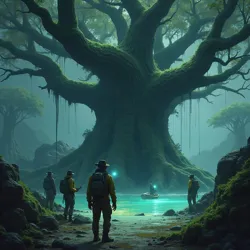Madlands of Tla'tlaqixi
 The Sacred Tree of Whispers in the depths of Tla'tlaqixi, known for inducing shared visions among those who shelter beneath its canopy
The Sacred Tree of Whispers in the depths of Tla'tlaqixi, known for inducing shared visions among those who shelter beneath its canopyThe Madlands of Tla'tlaqixi remain one of the most enigmatic and perilous regions in the Americas, where reality itself seems to bend and shift under the influence of countless psychoactive organisms. This remote area, whose name translates to "the Shunned Ones' slough" in Classical Nahuatl, continues to challenge our understanding of consciousness, biology, and the nature of perception itself.
Today's Featured Article: The Language of Altered States
The Tla'tlaqixi Linguistic Phenomenon represents one of the most fascinating aspects of this mysterious region. The local dialect, evolved from classical Nahuatl, has developed unique features that appear to be influenced by the constant exposure to consciousness-altering substances. The practice of Xochitl-speech demonstrates how language itself can become a vehicle for shared hallucinatory experiences.
Recent studies by the Institute of Ethnolinguistic Studies have documented over three hundred terms for different states of consciousness that have no equivalent in any other known language. These include words for specific shared hallucinations, temporal distortions, and what locals describe as "memories of future events." The dialect has also developed complex grammatical structures that appear to be designed to describe simultaneous experiences across multiple planes of reality.
Current Events
 Members of the Fungal Pattern Analysis Team documenting unusual growth formations near the Ancient Memory Pools
Members of the Fungal Pattern Analysis Team documenting unusual growth formations near the Ancient Memory PoolsThe Department of Biological Anomalies has reported an unprecedented surge in psychoactive fungal activity following the recent rainy season. This has led to increased incidents of synchronized hallucinations among both researchers and local inhabitants, particularly in the Black Cenote District. The Hartmann-Veracruz Expedition has established new monitoring stations to study this phenomenon.
Several villages near the Sacred Fungi of Mesoamerica growth zones have reported experiencing collective dreams that appear to be influenced by fungal spore patterns. These incidents have attracted attention from the Council of Consciousness Studies, which has dispatched a team to investigate potential links between fungal life cycles and human neural activity.
Historical Significance
The history of Tla'tlaqixi is inextricably linked to the Maqamiztleca, whose desperate flight from conquest led them to this transformative realm. Their adaptation to the region's unique properties resulted in the development of sophisticated systems for managing and utilizing various consciousness-altering organisms, many of which remain poorly understood by modern science.
The goddess Hmeyotlotl, originally associated with more benign aspects of fertility and herbcraft, underwent a dramatic transformation in local mythology. Her current incarnation as the "Mother of Madness" reflects the profound impact of the region's psychoactive ecology on religious and cultural practices. The annual Festival of the Melting Mind celebrates this transformation through carefully choreographed ritual exposure to various mind-altering substances.
Ecological Mysteries
The region's unique biological properties continue to challenge scientific understanding. The Vampire Hummingbird population has shown signs of developing new hunting strategies that appear to incorporate elements of precognition, while colonies of Tla'tlaqixi Giant Centipede have been observed engaging in what researchers tentatively describe as "collective consciousness behaviors."
The Boneshank Fungus has expanded its range significantly, leading to increased reports of skeletal modifications among affected organisms. This expansion has prompted renewed interest in the relationship between fungal networks and the various Yucatan Anomalous Zones documented throughout the region.
Research and Safety Protocols
Following the tragic Vanishing of the Morton Team, stricter protocols have been implemented for all research activities in the region. The Institute of Protective Protocols now requires all expeditions to maintain constant telemetric monitoring and employ specialized reality-anchoring techniques developed by survivors of previous incidents.
The condition known as Myco-afferent Ictus continues to affect both researchers and visitors, leading to enhanced screening procedures at all authorized entry points. Despite these precautions, operators of Tio Machete's Zipline Survival Course report increasing instances of tourists experiencing temporary dissolution of consensus reality.
Indigenous Knowledge Systems
Local communities maintain complex systems of knowledge regarding safe navigation of the region's psychological hazards. These systems, passed down through generations of shamanic practitioners, incorporate sophisticated understanding of the interaction between various psychoactive species and human consciousness. The recent documentation of the Ritual of Osseous Communion has provided new insights into these traditional practices.
The periodic release of Mindweaver Spores continues to play a crucial role in local spiritual practices, though scientists warn that exposure patterns have become increasingly unpredictable. Traditional knowledge keepers maintain that these changes reflect deeper shifts in the region's consciousness-affecting properties.
Scientific Investigations
Recent findings from the Quine Expedition have revealed new aspects of the region's unique properties, including evidence of synchronized behavioral patterns among normally solitary species during periods of intense psychoactive fungal activity. These discoveries have led to the development of new theories about consciousness and its relationship to fungal networks.
The ongoing documentation of Archaeological Mysteries of Tla'tlaqixi continues to uncover evidence of sophisticated ancient practices for managing and utilizing the region's consciousness-altering properties. These findings have been added to the comprehensive List of Unexplained Disappearances in Mesoamerica, as many sites appear to be associated with unusual temporal and spatial anomalies.
Tourism and Conservation
While the region appears in guides to Family Vacation Hotspots of the Lower Yucatán, access remains strictly controlled due to the unpredictable nature of its effects on human consciousness. Conservation efforts focus on maintaining the delicate balance between various psychoactive species while protecting traditional knowledge systems that have evolved to navigate these dangers.
The Megafauna of the Madlands continue to attract both scientific and tourist interest, though interaction with these creatures is carefully regulated due to their documented effects on human consciousness. Recent studies suggest that some species may be developing new forms of communication that incorporate elements of shared hallucination.
Current Research Initiatives
- Fungal Network Mapping Project
- Consciousness Alteration Documentation Initiative
- Indigenous Knowledge Preservation Program
See Also
- Psychotropic Ecology Studies
- Mesoamerican Mystery Zones
- Contemporary Shamanic Practices
References
The documentation of Tla'tlaqixi draws from a complex web of sources, including traditional oral histories, scientific expeditions, and the often-fragmentary records of those who have experienced its unique properties firsthand. Many aspects remain difficult to verify due to the region's effects on observation and memory.